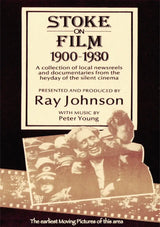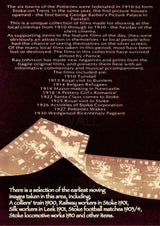The Book Shop
Stoke on Film 1900 to 1930 with the earliest moving pictures of the area historical DVD
The Staffordshire Film Archive has curated a fascinating collection of archival films and interviews that provide a glimpse into the region's history from 1900 to the end of the silent film era. This collection not only preserves the earliest moving images of Staffordshire but also captures the vibrant life of local communities as they embraced the new medium of cinema.
The films portray a diverse range of scenes and events, showcasing local people in their daily lives and significant historical moments. Highlights include:
- **A collier's train** arriving with coal miners crowding onto the platform in 1900, illustrating the importance of coal mining in the area.
- **Firemen and railway workers** captured in Stoke in 1901, reflecting the industrial character of the region.
- **Silk workers in Leek** and **Stoke football matches**, offering a view into local industries and sports that were central to community life in 1903 and 1904.
- Scenes from the **Stoke Locomotive Works** in 1910, celebrating the engineering prowess of the local industry.
- **Dustmen in Tunstall** from the same year, which provides insights into the daily routines of city workers.
The archive also features significant royal visits, such as that of **King George V and Queen Mary** in Burslem in 1913, and the king’s return in 1925 to proclaim Stoke a city. This event and its celebrations were captured on film, creating a lasting visual record of this important milestone.
Other notable moments include **Belgian refugees** during World War I and local political events, like a **mayor-making ceremony in Newcastle** in 1914. The melodrama **A Pottery Girl’s Romance**, filmed in Burslem in 1918, reflects the local culture and entertainment of the time.
The collection depicts **fairground scenes** at the Potteries Wakes in 1927, a lively local festival, and concludes with the **Wedgwood Bicentenary Pageant of 1930**, which brought together a vast cast and showcased the region's rich heritage in pottery.
Overall, these newly preserved prints, made possible through the efforts of Ray Johnson and the Staffordshire Film Archive, illuminate the social, cultural, and industrial life of Staffordshire over three decades and offer an invaluable resource for understanding the local history of the area.




